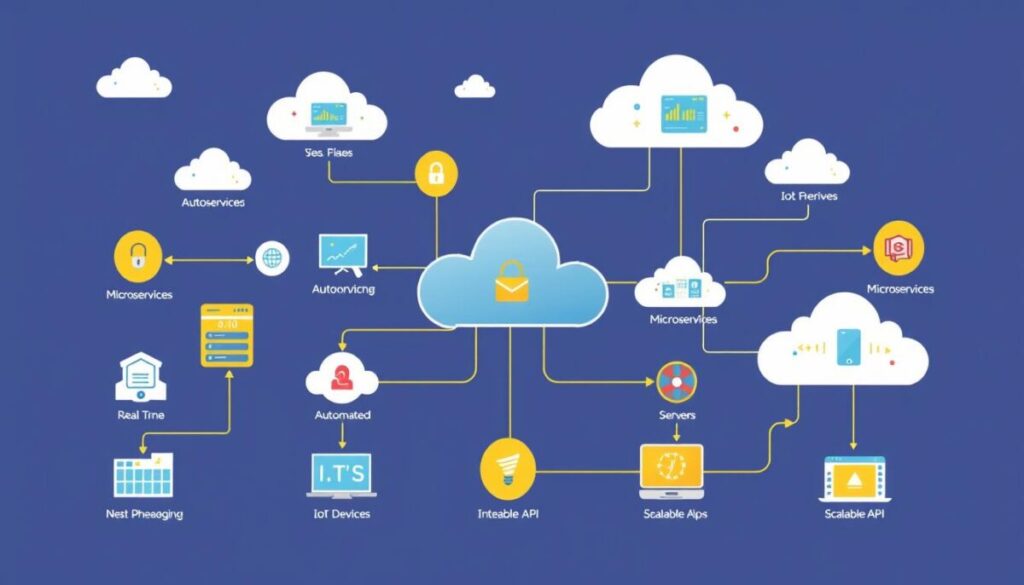In the realm of cloud computing, serverless architecture offers a groundbreaking method for application development and deployment. It eliminates the need to manage server infrastructure, allowing developers to concentrate on enhancing user experience and building features. This approach not only slashes operational costs but also scales automatically with demand, making it a cost-effective option for businesses today.
With the support of leading providers like AWS Lambda, Google Cloud Functions, and Microsoft Azure Functions, we can craft applications that scale and respond efficiently. This model empowers us to deliver rapid enhancements and updates, thanks to its event-driven nature. Computing resources are only allocated when needed, eliminating the need for backend server management. This streamlines our processes, enabling us to focus on delivering top-notch software solutions.
As we explore serverless architecture further, we find it significantly boosts developer productivity. It perfectly aligns with today’s demands for efficiency and effectiveness in software development. This makes it an ideal choice for modern businesses looking to stay competitive in a rapidly changing market.
What is Serverless Architecture?
Understanding serverless architecture can revolutionize how developers use cloud technology. It automates backend functions, freeing teams from server management constraints. This allows for more innovation.
Definition and Principles
Serverless architecture, also known as Function as a Service (FaaS), streamlines application deployment and management. The cloud provider handles server resources, so I can focus on coding. Each part of the application is a function, promoting scalability and efficiency.
How It Works in Cloud Computing
In cloud computing, serverless architecture works smoothly, with backend processes managed by the provider. When a function is triggered, like by a user action, the cloud allocates resources. This model boosts efficiency, as costs only apply when functions are used. It also handles traffic changes automatically, saving time.
Developers can focus more on coding and business logic, not server maintenance. This boosts productivity significantly.
Key Advantages of Serverless Architecture
More companies are turning to serverless architecture for its cost savings, scalability, and boost in developer productivity. The global serverless market hit $15 billion in 2023. It’s crucial to delve into these benefits, showing how serverless can revolutionize modern apps.
Cost-Effectiveness
The serverless model stands out for its cost management. It uses a pay-as-you-go pricing, where you only pay for what you use. This model cuts down on the costs of traditional server management, like buying hardware and maintenance. It optimizes resource use based on demand, making it a cost-effective option for variable workloads.
Improved Scalability
Serverless architecture offers better scalability, adapting to demand changes automatically. It scales up or down without human help. This is key for event-driven apps, where traffic can surge unexpectedly, like during sales. It ensures a smooth user experience, handling sudden demand spikes without complex infrastructure management.
Enhanced Developer Productivity
Serverless architecture simplifies infrastructure management, letting developers concentrate on coding and improving user experiences. This leads to more efficient coding and faster development. Teams can adopt agile methods, enabling quicker updates and deployments. This streamlined process helps developers meet user needs and adapt to market shifts, driving innovation and growth.
Serverless Architecture vs. Traditional Cloud Services
The shift in how businesses manage cloud services is marked by the contrast between serverless architecture and traditional infrastructure. Grasping these differences in management and scaling is crucial. It can greatly affect operational efficiency and cost-effectiveness.
Comparison of Management Responsibilities
Traditional cloud services require businesses to manage servers themselves. This includes maintaining servers, configuring resources, and scaling. Such tasks increase operational overhead, diverting time and resources from other business areas. Serverless architecture, on the other hand, delegates these tasks to cloud providers.
This change empowers businesses to focus on application logic and development. It frees them from the server maintenance burden, encouraging innovation.
Scaling Differences
Scaling in traditional infrastructure and serverless architecture differs significantly. Traditional cloud services demand meticulous capacity planning and manual scaling adjustments. This can result in inefficiencies, especially during traffic spikes.
Businesses may either over-provision or underutilize resources, leading to unnecessary costs. In contrast, serverless architecture scales resources automatically in real-time to match demand. It ensures optimal resource utilization and aligns expenses with usage.
While serverless environments may experience occasional latency due to cold starts, their dynamic scalability benefits generally outweigh these drawbacks. Moving to a serverless model can significantly improve operations and reduce costs.

Use Cases for Serverless Architecture
Serverless architecture has transformed how applications are developed and deployed, especially in modern scenarios. It streamlines processes and boosts efficiency across various sectors. Below are key use cases that highlight serverless’s effectiveness.
Web Applications and Microservices
Web applications and microservices greatly benefit from serverless architecture in today’s fast-paced world. By dividing applications into smaller components, I can deploy and scale each service independently. This modular setup leads to faster deployment and continuous updates to individual parts.
Serverless functions within microservices enable quick responses to user needs, ensuring a smooth experience.
Real-Time Data Processing
The need for real-time data processing is growing, and serverless architecture addresses this need effectively. It uses event-driven architecture to activate serverless functions on specific triggers, processing data immediately. This is crucial for applications like predictive analytics that require fast data processing.
Serverless solutions handle large volumes of transactions and data reliably and quickly, proving their effectiveness.
APIs and Backend Services
Serverless architecture simplifies the development of APIs and backend services. It allows for the creation of lightweight functions that execute tasks automatically upon request, eliminating the need for constant server presence. This setup reduces operational costs and enhances user experiences with faster responses.
Serverless architecture’s scalability ensures backend services can handle changing user demands without expensive upgrades. It also streamlines integration with third-party services, enriching application capabilities.

Conclusion
Exploring serverless architecture’s benefits is key for organizations seeking operational efficiency in today’s fast-paced cloud strategy landscape. Adopting serverless solutions helps businesses reduce infrastructure management burdens. This allows them to focus more on improving user experiences and optimizing application development.
Serverless architecture enables developers to use a pay-as-you-go model. Costs are directly tied to resource consumption, not idle capacity. This approach can lead to significant cost savings over time. Moreover, as service providers like AWS Lambda, Google Cloud Functions, and Azure Functions expand, using these technologies becomes crucial for creating innovative solutions.
By understanding and implementing serverless architecture, companies can leverage scalability and rapid deployment capabilities. The market for serverless computing is expected to grow substantially in the coming years. Businesses that invest in this cloud strategy will likely gain a competitive edge. This will pave the way for greater agility and responsiveness.



